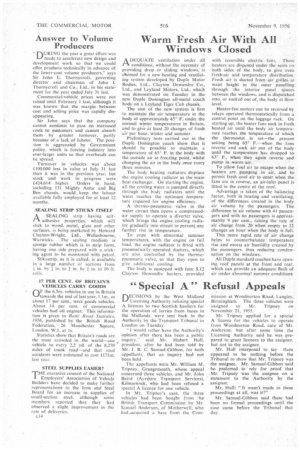Warm Fresh Air With All Windows Closed
Page 52

If you've noticed an error in this article please click here to report it so we can fix it.
A DEQUATE ventilation under all .t3. conditions, without the necessity of providing drop or sliding windows; is clrairned for a new heating and ventilating system developed by Duple Motor Bodies. Ltd., Clayton DewandreCo., Ltd., and Leyland Meaors, Ltd., which was demonstrated on Tuesday in the new Duple Donington all-metal coach body on a Leyland Tiger Cub chassis.
The aim of the new •system is first to maintain the air temperature in the body at approximately 65° F. under the normal winter temperatures in Britain, and to give at least 20 changes of fresh air per hour, winter and summer.
Preliminary tests carried out in the Duple Donington coach show that it should be possible to maintain a temperature of 65° F. in the body with the outside air at freezing point, whilst changing the air in the body once every three minutes.
The body heating radiators displace the engine cooling radiator as the main heat exchanger. On starting the engine, all the cooling water is pumped directly through the body radiators until the water reaches the optimum temperature required for engine efficiency.
A therrno-pneumatic valve in the water circuit then opens a compressedair supply to operate a diverter valve. which brings the engine cooling radiator gradually into circuit to prevent any further rise in temperature.
To cope with abnormal summer temperatures, with the engine on full load, the engine radiator is fitted with pneumatically operated shutters, which are also controlled by the thermopneumatic valve, so that they open to give additional cooling.
The body is equipped with four S.12 Clayton Dewandre heaters, provided
with reversible electric fans. These heaters are disposed under the seats on both sides of the body, to give even fresh-air and temperature distribution. Fresh air is ducted from air grilles at waist height in the outer panelling through the interior panel spaces between the windows, and is dispatched into, or sucked out of, the body at floor level.
Heater-fan motors can be reversed by relays operated thermostatically from a central point on the luggage rack. On starting up. the heater fans suck in fresh heated air until the body air temperature reaches the temperature at which the thermostat is set—the present setting being 65° F.—when the fans reverse and suck air out of the body until the temperature has dropped to 63° F., when they again reverse and pump in warm. air.
To allow foul air to escape when the heaters are pumping in air, and to permit fresh cool .air to enter when the fans arc in reverse, an air-inlet panel is fitted in the centre of the roof.
Advantage is taken of the balancing factor, both in heating and ventilating. of the differences created in the body air volume by the passengers. The difference in air volume with 41 passengers and with no passengers is approximately 9 per cent., raising the rate of air change from 20 when empty to 22 changes an hour when the body is full.
This more rapid rate of air change helps to counterbalance temperature rise and excess air humidity created by the passengers, thus reducing condensation on the windows.
All Duple standard coaches have opening roof panels at the front and rear, which can provide an adequate flush of air under abnormal summer conditions.




























































































































